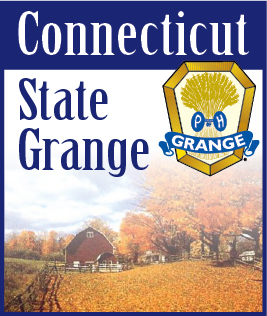 |
|
 |
|
 |
|
 |
 |
| Around The Grange |
|
 |
Vo-Ag programs adapt to changing needs |
| |
By By John Penney - Norwich Bulletin (January 22, 2008) |
| |
FEBRUARY 2008 --
KILLINGLY - Inside Killingly High School’s agriculture mechanical shop, sophomore and future farm owner J. Allen Cameron was busy fitting silver chainsaw teeth onto a naked cutting handle.
“I grew up in the suburbs in Plainfield,” said Cameron, 16. “But I like the idea of being able to fix my own equipment. I’ve worked a couple of farms like my father and uncle did, so I’d like to own my own dairy farm.”
Cameron is one of approximately 100 agriculture science and technology students enrolled at Killingly High School’s Agriculture Education Center this year, a number that’s remained steady despite shrinking farmland, tuition inequities and misconceptions about the program’s mission.
Connecticut is home to 19 high school-based, regional vocational agriculture centers. During the past 13 years, they showed a total enrollment bump of almost 50 percent, according to the state Department of Education.
This rising interest in agricultural studies is in sharp contrast with the steadily shrinking amount of farmland in the state. According to a report by the Connecticut Farmland Trust, about 8,000 acres of the state’s farmland disappears each year under residential and commercial development.
The solution for agricultural schools is to anticipate the evolution of farming needs and prepare students for life beyond the barn, said Bonnie Kegler, the school’s animal science instructor.
“Only the smallest percentage of our students are going into actual farming,” she said. “These kids aren’t coming here to learn how to harrow a field. They’re dissecting animals, learning landscaping and growing and selling local produce and eggs. They’re learning science and the importance of niche marketing.”
Killingly High senior William Robillard hopes to parlay a science-heavy curriculum into a career. The 17-year-old aquiculture student from Griswold edged his way between bubbling tanks of koi, catfish and tilapia Wednesday — fish that will be eventually sold to students and faculty to cover feed costs.
“I’ve always been an outdoor person, so I’ll apply to the Department of Environmental Protection after college,” said Robillard. “We’re learning everything from tracking and identification techniques, to the chemical and physical aspects of these animals.”
In addition to class content, the vo-ag student profile also has changed, said Ken Couture, aquiculture and natural resource instructor.
“These kids are taking classes in math, English and science just like their peers, and most of them are taking college prep courses,” he said. “In addition, the vo-ag program runs 12 months a year, so instructors are checking up on student projects during the summer.”
In addition to fighting program stereotypes, vo-ag programs also are battling some funding inequities, said Doug Butterfield, the school’s vocational agriculture coordinator. He said the majority of the school’s vo-ag students, like Robillard and Cameron, come from outside Killingly, requiring sending towns to pay nearly $8,000 in annual tuition per student. That’s not the case for students who chose to attend the region’s technical high schools.
“We’re writing checks for $212,000 this year to send 30 vo-ag students to Killingly,” said Plainfield Superintendent of Schools Mary Conway. “But the students we’re sending to technical schools in Norwich, Killingly and Groton are paid for by the state.”
The disparity between funding coincides with a statewide push towards more technological-based school programs and a jump in technical employment demand.
Quinebaug Valley Community College recently added several new courses focusing on computer and engineering skills to its curriculum. At the same time, the state Department of Labor ranked technology jobs at the top of its list of fastest growing occupations.
Killingly’s vo-ag program is scheduled to get a facelift in the coming years in connection with the new high school project. The new $14 million vo-ag center will cover 30,000 square feet, or 22,000 square feet more than the current space, Butterfield said.
“The vocational agriculture center will be 100 percent reimbursable by the state,” Butterfield said. “We’ll have an aquiculture center that’s four times as big as the one we have now, a greenhouse and more overhead shop doors.”
For senior Georgia, 17, the main attraction of the vocational agriculture program isn’t state-of-the-art equipment or vocational opportunities, but rather the skills she’s garnered through three years of study.
“I took these classes because they interested me,” said Williamson, an Eastford resident. “I’ve learned about the importance of buying locally and how that affects industry and the community.”
|
| |
|
| |
|
|
| Click an image to view the larger photo |
|
|
| |
|
| |
|
Your rating has been saved
|
|
|
|
|
|
|
 |
| |
 |
|
|
|
|
